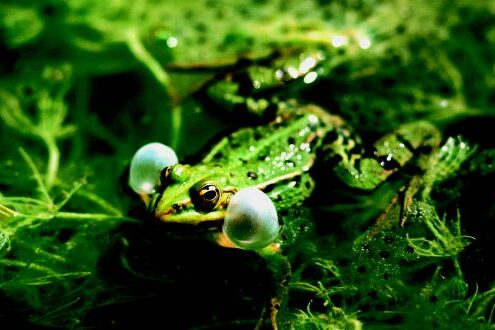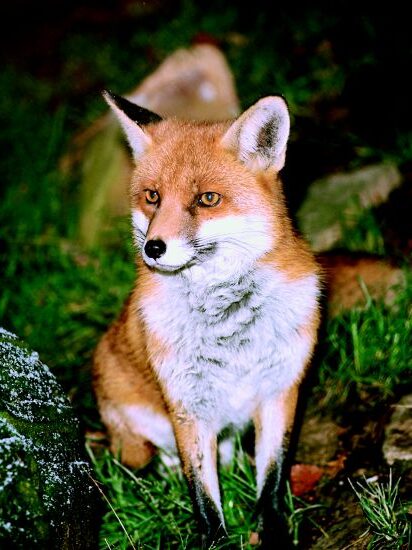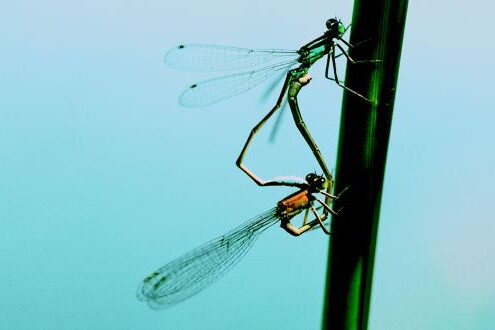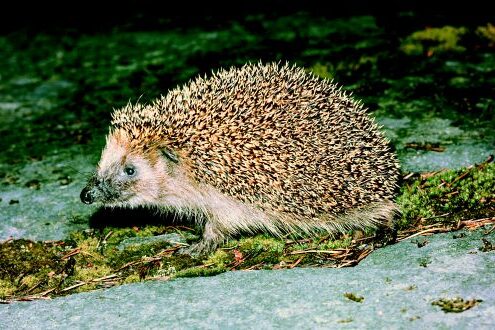Wildlife of Wiesbaden
Wiesbaden's animal world is characterized by a great diversity of species, which is due to the favourable climate and the variety of biotopes. Many species find both food and space to raise their offspring here. The city's permanent residents include some rare, endangered species as well as exotic immigrants.
Wiesbaden, a large city with around 270,000 inhabitants, offers extremely diverse habitats for flora and fauna. Only around a quarter of the city's area is urban, but three quarters is made up of other landscapes. Among these are partly nature-protected river and floodplain landscapes along the Rhine, agricultural land with a high proportion of fruit growing and viticulture as well as large areas of forest. Climatically, Wiesbaden is characterized by high average annual temperatures and very low rainfall. At 9.5 - 10.0 °C and 550 - 650 mm, the lower-lying districts are among the warmest areas in Hesse with the lowest precipitation. The inner city area is characterized - not least due to its long tradition as a spa and health resort town - by a high and in part very old stock of trees, numerous avenues and several parks and cemeteries, some of which are planted with exotic plants. The extensive forests of the Taunus, which border Wiesbaden to the north, reach submontane heights of up to 618 m above sea level in some places within the city limits (Hohe Wurzel).
The already relatively warm climate of the Mainz basin and the Rheingau, as well as the urban heating, favor the establishment of warmth-loving, originally Mediterranean or Pontic (southeastern European) species in the parts of the city close to the Rhine. In contrast, the forested areas of the Taunus are already significantly cooler and have more precipitation and therefore provide a habitat for animals that are characteristic of temperate latitudes or require wetland biotopes (such as amphibians). While Wiesbaden, as is generally the case in urban areas of large cities, is home to a rather large variety of species, the surrounding farmland and forest landscapes with mostly intensive use are comparatively species-poor because fallow land and ecological niches have been greatly reduced. However, Wiesbaden also has some very valuable biotopes here, such as orchards(meadow orchards) and dry, warm mountain slopes, some of which have fallen into disuse, as well as several nature reserves.
In the urban core area, many animals benefit from various favorable factors: gardens, cemeteries and parks offer protected habitats, nesting sites and food. In addition, there is a large food supply due to the throwaway society and a variety of biotopes that can develop, for example, on industrial wasteland and in "poorly" maintained gardens. This more than compensates for the undoubtedly negative aspects of urban habitats such as road traffic, pollution and the isolation of biotopes. Honey bees produce higher yields due to the large number of flowering plants, and foxes, gulls, storks, birds of prey and ravens, for example, are regularly observed on the landfill sites in the Dyckerhoff quarry due to the rich food supply. Animals such as the striking black and red-colored common fire bug are also found much more frequently in urban areas than in the countryside.
The city's permanent residents also include some exotic and rare animal species such as the unmistakable collared parakeets and the shy Aesculapian snake. There are also a large number of native animal species, including numerous endangered species. These find suitable habitats in Wiesbaden's urban area, but also benefit in many places from targeted protection and settlement measures by initiatives such as the Schierstein stork community and nature conservation associations and authorities. The Rhine and the floodplain landscapes, some of which have been renaturalized and are protected, are one reason why there are a particularly large number of birds and aquatic animals among the endangered species living in Wiesbaden.
Animals of the Rhine and its margins
The ecosystem along the Rhine, including the mouth of the Main, has undergone such serious changes over the last 200 years due to human influences that only a small proportion of the original species composition is still present. Navigability, bank straightening with various intensive uses, but especially the water pollution of the Rhine, which was particularly significant in the 20th century and peaked in the early 1970s, should be mentioned here. The proportion of natural floodplains and flooded areas decreased significantly.
The colonization of some neozoa has also contributed to the change in the fauna of the Rhine. These are animals that have settled permanently in new areas, usually as a result of human influence. For example, native crayfish were largely wiped out in the 19th century by the so-called mussel plague. In order to preserve the crayfish fishery, the American crayfish (Orconectes limosus), which is immune to the disease, was deliberately released in 1890 and has since become a permanent resident. Another newcomer is the basket mussel (Corbicula fluminea), which only arrived from East Asia in the mid-1980s and now colonizes the Rhine in large numbers.
Water pollution has decreased considerably since the mid-1970s, when only 17 fish species were recorded in the local section of the Rhine, and a regeneration of species richness has been observed since then. Today, more than 40 fish species can be found in the Hessian section of the Upper Rhine. These are dominated by bream (Abramis brama) and roach (Rutilus rutilus), while glances (Blicca bjoerkna) and perch (Perca fluviatilis) are also common. The Rhine fish population of earlier centuries had a completely different composition: barbel (Barbus barbus), nase (Chondrostroma nasus) and bleak (Alburnus alburnus) are listed as the dominant species up to the 19th century.
The regeneration of the river landscape has also been helped by the designation of some floodplain landscapes as nature reserves. However, in the densely populated, intensively and diversely used region, these represent only a small near-natural habitat, which in part consists of isolated biotopes. Similar to the fish population, the species composition of the regenerating fauna of the floodplains differs greatly from the original fauna.
The protected floodplain landscapes naturally provide a habitat for many water birds, with the Rettbergsaue nature reserve being the most important for birds in Wiesbaden. Many other animal species, some of them rare, have also settled here. Censuses have revealed a great diversity of bird species, with 19 birds on the Red List of Threatened Species alone breeding there. In addition, many other endangered animal species have also been recorded, e.g. more than ten species of grasshopper, numerous butterflies and pond and lake frogs.
Along the Rhine, you can often observe grey herons and the strictly protected black kites in search of food, which certainly indicates a certain abundance of fish. Even without much knowledge of the species, you will soon become aware of another special feature of Wiesbaden's wildlife: the numerous white storks, whose nests can be found particularly between Schierstein and Walluf. Storks were extinct in Wiesbaden, as in the whole of Hesse, in the course of the 20th century. Since 1972, citizens of Schierstein, who are organized in the Storchengemeinschaft Schierstein e.V., have been trying to reintroduce white storks. After initial failures, the first breeding successes were achieved in the mid-1970s. This was partly due to the generally favorable habitat, but was also based on the exchange of experience with other reintroduction projects and not least the support of Wiesbaden's public utility company (ESWE Versorgungs AG), which provided the extensive water extraction site between Schierstein and Walluf, which was not open to the public. The storks find shelter there, and there are also abundant sources of food and numerous artificial nesting sites. After an initially slow development to around nine breeding pairs in 1997, a significant increase has been observed since then, with 18 breeding pairs and around 80 individuals in 2012. Nests can now be found not only on chimneys, artificial and natural nesting sites, but also several times and visibly from afar on some electricity pylons in the Schierstein area, some of which must support several nests at once.
The reasons for the strong increase in storks, for which additional measures such as feeding and keeping flightless ground storks are no longer necessary, are still unknown. It is probably favored by the good food supply in the floodplain landscapes along the Rhine, which provides the storks with a natural livelihood.
However, there may also be other reasons, including displacement from other breeding areas.
The disappearance of some ground breeders such as the tree pipit (Anthus trivialis) and the yellow wagtail (Motacilla flava) is associated with the relatively high number of storks in a small area. Institutions responsible for bird protection are also rather critical of the settlement of storks in Schierstein because it is a population with unnatural behavior patterns and because other species are threatened or displaced.
Animals in inner-city areas
Wiesbaden's urban area is home to many natural inhabitants such as hedgehogs, squirrels and rabbits, pigeons and of course a large number of unwanted animals such as rats and mice. Many people are also aware of the presence of the stone marten (Martes foina), an animal that is very important for the decimation of rodents, but is considered a nuisance because of its tendency to bite car parts.
The city's parks and high tree population provide a good habitat for numerous native bird species, as well as immigrants such as exotic parakeets and the Egyptian goose (Alopochen aegyptiacus).
Even formerly shy forest animals such as the blackbird have adapted to life in cities and colonize them extensively. Another example is the frequent occurrence of the red fox. These nocturnal animals, which mainly feed on mice, but also earthworms, fruit and, last but not least, waste, are regularly observed in urban areas, e.g. in the southern cemetery.
Other animal species, some of which have become rare in Germany and are under protection, also live in the city, such as the hazel dormouse (Muscardinus avellanarius), the small relative of the house mouse, the blue-winged damselfly (Calopteryx virgo) or the damselfly (Ischnura pumilio) as well as at least four other dragonfly species. The privet hawk moth (Sphinx ligustri), a moth that is one of the largest butterflies in Europe with a wingspan of 80 - 120 mm, also finds a habitat in Wiesbaden due to the relatively frequent privet hedges.
Domestic bats such as the grey long-eared bat (Plecotus austriacus), which has its main distribution in the warm Rhine Valley, are regularly found in Wiesbaden. These and a total of nine other bat species, some of which are rare, have been documented for Wiesbaden by the Working Group for Bat Conservation, which has been committed to the conservation of bats since 1983.
Animals in the field and forest
Almost 28% of Wiesbaden's urban area consists of forest and around 30% of agricultural land with a high proportion of vineyards and orchards. The predominantly intensive agricultural and forestry use is one of the reasons for the rather low species richness described above. Several nature reserves (Rabengrund, Wickerbachtal, Sommerberg) contribute to the preservation and reintroduction of many animals.
The diversity and permanent settlement of rare and endangered animal species is also promoted by conservation measures of the Environmental Agency and various nature conservation groups. As part of the European Union's Fauna-Flora-Habitat Directive, efforts are being made to ensure that important biotopes are preserved or replaced. Through advice and cooperation with farmers, the mowing of meadows is adapted to the rhythm of life of certain plant and animal species and farmers are granted compensation payments in the event of disadvantages. For the field hamster (Cricetus cricetus), which occurs near Delkenheim, Nordenstadt, Schierstein and Dotzheim, there is a special protection program in which farmers leave crop stubble standing and do not carry out deep ploughing. Another example is that the meadow knob (Sanguisorba officinalis) is spared from mowing because it serves as a habitat for a rare butterfly species, the bog blue (Phengaris teleius), which occurs in the Rabengrund, Goldstein and Wickerbach valleys. As butterflies only live for a few weeks, postponing the mowing period can be crucial in providing a livelihood for these animals.
The partial study for the 2010 landscape plan emphasized the importance of orchard meadows as a particularly species-rich habitat worthy of protection, especially for wildlife. Orchard meadows are quite common in Wiesbaden and a very high diversity of species, especially of many endangered and protected species, was identified in the aforementioned study. For example, 32 different butterfly species alone were identified in an orchard area near Breckenheim. The widespread distribution of the redstart (Phoenicurus phoenicurus), which is classified as endangered and is a characteristic species of this biotope type, also underlines the importance of orchard meadows for species conservation. Their isolation is considered critical for the sustainable protection of the habitats of rare and protected species.
The numerous streams that flow down from the Taunus through forests, fields and towns to the Rhine represent another important habitat for animals. Due to acidification, intensive water use, wastewater discharge and construction, many streams have been and still are largely deprived of their ecological functions. Many streams are gradually being renaturalized by the Environment Agency and with the support of many citizens and associations committed to environmental protection. For example, the renaturation and upgrading of the part of the Wellritz Valley adjacent to the city center as a landscape park is already well advanced. In the course of the renaturation efforts, detailed studies of the fauna indicating the water quality have also been carried out in recent decades. For most streams, many indicator species for water quality such as caddisflies (Silo pallipes) or freshwater shrimps (Gammarus fossarum) were found, at least in the upper reaches. Some Red List species such as river snails (Ancylus fluviatilis) are also found in many streams. Fish populations have also been recorded, e.g. brown trout in the Dambach, Klingenbach and Goldsteinbach, as well as the three-spined stickleback on several occasions.
Reptiles and amphibians are particularly prevalent in the cooler and wooded northern parts of the city. In addition, some particularly thermophilic reptile species (wall lizard and Aesculapian snake) also find suitable habitats in warmer, lower-lying biotopes, e.g. the vineyards near Frauenstein. There is relatively reliable information on the occurrence of both reptiles and amphibians, in particular based on the results of the partial study for the land use plan with data for 2009 and a mapping from 1996/97. The most common amphibians in Wiesbaden are the grass frog (Rana temporaria) and the common toad (Bufo bufo); fire salamanders (Salamandra salamandra) are also not uncommon. As in the Rheingau, all of these species have been found almost exclusively in predominantly wooded biotopes in the Wiesbaden city area, while there have been almost no findings near the Rhine. Several newt species (Triturus spec.) with a similar distribution area are also found.
Spawning waters for several amphibian species can be found in the Goldstein Valley and other water-rich areas. Here, as in other places, attempts are being made to safeguard species diversity through active measures, such as the erection of protective fences for toad migration or the preservation of spawning waters.
Several reptile species are native to the forests of Wiesbaden. Grass snakes and slow worms are the most common, followed by the common lizard (Zootoca vivipara) and the Aesculapian snake. The sand lizard (Lacerta agilis) is very common in urban areas and areas close to the Rhine, while the wall lizard (Podarcis muralis) has mainly been found on a natural stone wall in the south-eastern part of the city and must be regarded as an endangered species.
The Taunus is home to large hunting animals and numerous other mammals. These include the red deer (Cervus elaphus), the largest wild animal in the urban area, roe deer (Capreolus capreolus), the most common European deer species, and many wild boar (Sus scrofa), which often venture into parks and gardens in search of food. Stag beetles, wildcats, smooth snakes, black and red kites, tree falcons, peregrine falcons, black storks and eagle owls are among the rare animal species that are native to the region's forests and for which the Wiesbaden-Chausseehaus forestry office has taken on regional management as part of the European nature conservation network NATURA 2000. This also includes a belt of old beech forests on the edge of the Wiesbaden urban area. In addition, there are occasional reports of lynxes, the largest cats of prey in Europe, being observed in the area of the forestry office.
The Wiesbaden-Chausseehaus forestry office has also taken over the sponsorship of the Aesculapian snake and the honey buzzard and implemented a series of measures to promote them. Forest meadows were enlarged and cleared, vegetation was removed from old quarries and small temporary bodies of water were dammed.
Exotic immigrants
Many rare and conspicuous neozoa also benefit from the dry and warm climatic conditions. Three species of grasshopper (blue-winged grasshopper, western biting grasshopper and vine grasshopper) have found a habitat along the railroad tracks between the ballast stones. These species have migrated from the Mediterranean and the Crimean peninsula. The Spanish flag, a butterfly species that needs forest edges where oregano grows as a habitat, has also settled in Wiesbaden.
The occurrence of the aforementioned Aesculapian snake is proof of Wiesbaden's favorable climate for warmth-loving animals. The snake, which can grow up to 2 m long, feeds on small animals, mice, lizards and birds' eggs and is completely harmless to humans. It is known by the Aesculapian staff, a symbol of the medical profession. Native to the Mediterranean, it can only be found in a few regions in Germany. Its occurrence in the current urban area of Wiesbaden and the neighboring Rheingau region has been known and well documented for a very long time. It is possible that the Aesculapian snake was introduced by the Romans, according to another theory it is said to have settled here after the last ice age. They can be found in particular around the Frauenstein district, where the Naturschutzhaus im Lindenbachtal association has created a snake trail and offers guided tours. Their presence has also been documented on the Geisberg.
Since around 1970, two species of parakeet have managed to settle in Wiesbaden. These are the collared and Alexander's parakeets (Psittacula krameri and Psittacula eupatria), which are particularly noticeable in Biebrich Palace Park and are native to southern Asia from India to Vietnam. Favored by Wiesbaden's tree population, the mild climate and sufficient food sources, they managed to settle permanently in Wiesbaden. Interestingly, the period of permanent settlement coincides with an increase in the average temperatures measured for Wiesbaden, which have been rising continuously since around 1900, but have risen even more steeply since around 1988. Both parakeet species predominantly breed in tree cavities in plane trees. The old tree populations in various parks offer the parakeets not only suitable nesting sites but also a variety of food sources. Seeds and leaves, but also fruit, are consumed by the parakeets. In 2000, 120 breeding pairs of collared parakeets and 23 of Alexander's parakeets were counted, corresponding to around 500 and 80 individuals respectively. In Germany, these and a few other exotic parakeet species have only managed to settle permanently in a few large cities with relatively warm climates, mostly along the Rhine (e.g. Heidelberg, Cologne, Bonn). Some bird and nature conservationists are critical of the spread of these neozoans, as the ecological interference can lead to the displacement of native cavity-nesting birds or food competitors such as woodpeckers, jackdaws or starlings. However, there is as yet no concrete evidence of any actual displacement of species in Wiesbaden.
Literature
- Erpelding, Georges
Watercourses in Wiesbaden. Limnofaunistic baseline survey and water quality mapping 1988. Environmental department of the state capital Wiesbaden (ed.), Wiesbaden 1992.
- Fuhrmann, Malte
Herpetological mapping 1996/97 in the Rheingau-Taunus district and in Wiesbaden, final report 1998, Naturschutzhaus Wiesbaden e.V. (ed.), 1998.
- Nassauischer Verein für Naturkunde (Hrsg.)
Jahrbücher des Nassauischen Vereins für Naturkunde 121, Wiesbaden 2000.
- Landeshauptstadt Wiesbaden – Umweltamt (Hrsg.)
The flora and fauna in outdoor areas. Partial investigation of the landscape plan at land use plan level, Wiesbaden 2010.
- Nassauischer Verein für Naturkunde (Hrsg.)
Streifzüge durch die Natur von Wiesbaden und Umgebung, Wiesbaden 2012, 2nd edition.






